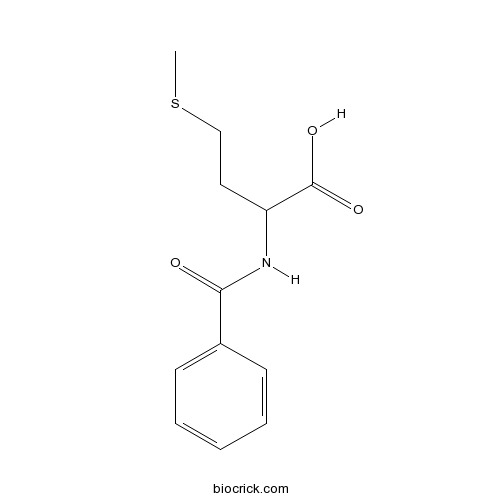Benzoyl-DL-methionineCAS# 4703-38-2 |

Quality Control & MSDS
3D structure
Package In Stock
Number of papers citing our products

| Cas No. | 4703-38-2 | SDF | Download SDF |
| PubChem ID | 295480 | Appearance | Powder |
| Formula | C12H15NO3S | M.Wt | 253.3 |
| Type of Compound | N/A | Storage | Desiccate at -20°C |
| Solubility | Soluble in Chloroform,Dichloromethane,Ethyl Acetate,DMSO,Acetone,etc. | ||
| Chemical Name | 2-benzamido-4-methylsulfanylbutanoic acid | ||
| SMILES | CSCCC(C(=O)O)NC(=O)C1=CC=CC=C1 | ||
| Standard InChIKey | PPFRJEXUPZWQPI-UHFFFAOYSA-N | ||
| Standard InChI | InChI=1S/C12H15NO3S/c1-17-8-7-10(12(15)16)13-11(14)9-5-3-2-4-6-9/h2-6,10H,7-8H2,1H3,(H,13,14)(H,15,16) | ||
| General tips | For obtaining a higher solubility , please warm the tube at 37 ℃ and shake it in the ultrasonic bath for a while.Stock solution can be stored below -20℃ for several months. We recommend that you prepare and use the solution on the same day. However, if the test schedule requires, the stock solutions can be prepared in advance, and the stock solution must be sealed and stored below -20℃. In general, the stock solution can be kept for several months. Before use, we recommend that you leave the vial at room temperature for at least an hour before opening it. |
||
| About Packaging | 1. The packaging of the product may be reversed during transportation, cause the high purity compounds to adhere to the neck or cap of the vial.Take the vail out of its packaging and shake gently until the compounds fall to the bottom of the vial. 2. For liquid products, please centrifuge at 500xg to gather the liquid to the bottom of the vial. 3. Try to avoid loss or contamination during the experiment. |
||
| Shipping Condition | Packaging according to customer requirements(5mg, 10mg, 20mg and more). Ship via FedEx, DHL, UPS, EMS or other couriers with RT, or blue ice upon request. | ||

Benzoyl-DL-methionine Dilution Calculator

Benzoyl-DL-methionine Molarity Calculator
| 1 mg | 5 mg | 10 mg | 20 mg | 25 mg | |
| 1 mM | 3.9479 mL | 19.7394 mL | 39.4789 mL | 78.9578 mL | 98.6972 mL |
| 5 mM | 0.7896 mL | 3.9479 mL | 7.8958 mL | 15.7916 mL | 19.7394 mL |
| 10 mM | 0.3948 mL | 1.9739 mL | 3.9479 mL | 7.8958 mL | 9.8697 mL |
| 50 mM | 0.079 mL | 0.3948 mL | 0.7896 mL | 1.5792 mL | 1.9739 mL |
| 100 mM | 0.0395 mL | 0.1974 mL | 0.3948 mL | 0.7896 mL | 0.987 mL |
| * Note: If you are in the process of experiment, it's necessary to make the dilution ratios of the samples. The dilution data above is only for reference. Normally, it's can get a better solubility within lower of Concentrations. | |||||

Calcutta University

University of Minnesota

University of Maryland School of Medicine

University of Illinois at Chicago

The Ohio State University

University of Zurich

Harvard University

Colorado State University

Auburn University

Yale University

Worcester Polytechnic Institute

Washington State University

Stanford University

University of Leipzig

Universidade da Beira Interior

The Institute of Cancer Research

Heidelberg University

University of Amsterdam

University of Auckland

TsingHua University

The University of Michigan

Miami University

DRURY University

Jilin University

Fudan University

Wuhan University

Sun Yat-sen University

Universite de Paris

Deemed University

Auckland University

The University of Tokyo

Korea University
- Cineole
Catalog No.:BCN2686
CAS No.:470-82-6
- 1-Kestose
Catalog No.:BCN8292
CAS No.:470-69-9
- Stachyose tetrahydrate
Catalog No.:BCC8252
CAS No.:470-55-3
- Marinobufagin
Catalog No.:BCC9238
CAS No.:470-42-8
- Cinobufagin
Catalog No.:BCN5367
CAS No.:470-37-1
- Isoalantolactone
Catalog No.:BCN4955
CAS No.:470-17-7
- Uncarine D
Catalog No.:BCC8262
CAS No.:4697-68-1
- Carbenicillin
Catalog No.:BCC5192
CAS No.:4697-36-3
- 5'-IMPdisodium salt
Catalog No.:BCN8175
CAS No.:4691-65-0
- Jervine
Catalog No.:BCN2975
CAS No.:469-59-0
- Cycloeucalenol
Catalog No.:BCN5519
CAS No.:469-39-6
- Hamamelitannin
Catalog No.:BCC8182
CAS No.:469-32-9
- Beta-Lapachone
Catalog No.:BCC5088
CAS No.:4707-32-8
- alpha-Lapachone
Catalog No.:BCN5520
CAS No.:4707-33-9
- Atraric acid
Catalog No.:BCN5521
CAS No.:4707-47-5
- 8-Amino-7-oxononanoic acid
Catalog No.:BCN1778
CAS No.:4707-58-8
- Glycyrrhetinic acid
Catalog No.:BCN5942
CAS No.:471-53-4
- Isocolumbin
Catalog No.:BCN5361
CAS No.:471-54-5
- alpha-Boswellic acid
Catalog No.:BCN5522
CAS No.:471-66-9
- Dipterocarpol
Catalog No.:BCN5523
CAS No.:471-69-2
- (-)-Steviol
Catalog No.:BCN8358
CAS No.:471-80-7
- Stachydrine
Catalog No.:BCN8384
CAS No.:471-87-4
- Bufotaline
Catalog No.:BCN5368
CAS No.:471-95-4
- (E)-Aldosecologanin
Catalog No.:BCN4631
CAS No.:471271-55-3
Fiber-optic singlet oxygen [1O2 (1Delta(g))] generator device serving as a point selective sterilizer.[Pubmed:20497367]
Photochem Photobiol. 2010 Jul-Aug;86(4):890-4.
Traditionally, Type II heterogeneous photo-oxidations produce singlet oxygen via external irradiation of a sensitizer and external supply of ground-state oxygen. A potential improvement is reported here. A hollow-core fiber-optic device was developed with an "internal" supply of light and flowing oxygen, and a porous photosensitizer-end capped configuration. Singlet oxygen was delivered through the fiber tip. The singlet oxygen steady-state concentration in the immediate vicinity of the probe tip was ca 20 fm by N-Benzoyl-DL-methionine trapping. The device is portable and the singlet oxygen-generating tip is maneuverable, which opened the door to simple disinfectant studies. Complete Escherichia coli inactivation was observed in 2 h when the singlet oxygen sensitizing probe tip was immersed in 0.1 mL aqueous samples of 0.1-4.4 x 10(7) cells. Photobleaching of the probe tip occurred after ca 12 h of use, requiring baking and sensitizer reloading steps for reuse.


